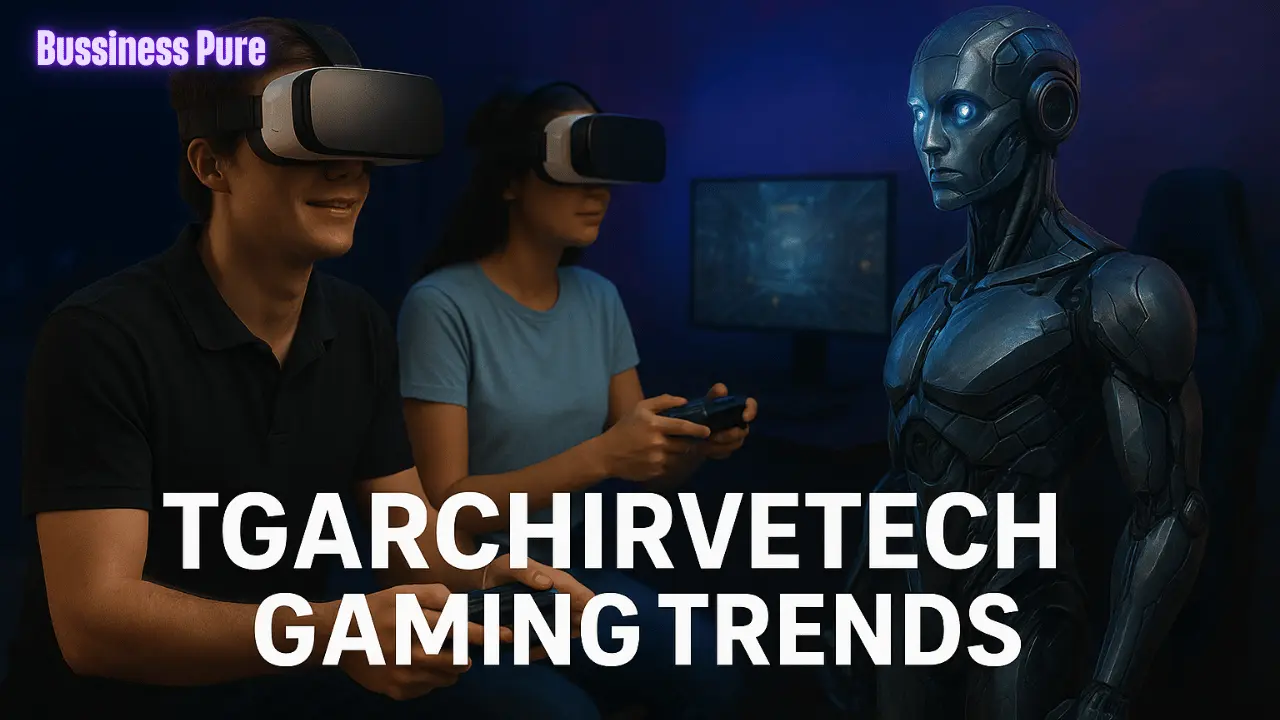Introduction
The gaming industry in 2025 is not just evolving — it’s transforming. Under the banner of “Tgarchirvetech” (a coined term for the intersection of technological innovation, creative systems, and community-first design in gaming), we’re seeing powerful shifts in how games are developed, delivered, monetized and experienced. From cloud-native streaming to AI-augmented content creation, and from modular creator economies to adaptive procedural systems, Tgarchirvetech trends are what separate lasting game ecosystems from one-hit wonders.
These trends matter not only because they reflect what the top studios are doing, but because they show where the opportunities are for smaller studios, creators, platforms and players. By understanding the principles behind Tgarchirvetech — rather than just the technologies — you can apply them in ways appropriate to your scale and market. This article covers the key pillars of Tgarchirvetech, real-world signals that validate them, practical steps you can take, ethical and business considerations, and what the road ahead looks like. If you’re a developer, publisher, creator or serious player, this is your 2025 guide to staying ahead.
The Five Pillars of Tgarchirvetech
Here are the core areas where transformative change is occurring, and which together form the backbone of the Tgarchirvetech framework.
1. AI-Augmented Content Creation
Increasingly, game studios use artificial intelligence not just as a tool for automation, but as a creative partner. AI can generate textures, dialogues, routines for NPCs, even entire level layouts. This means content pipelines shrink and iteration speeds rise. But the real power lies in personalization — dynamic narratives, adaptive challenges or reactive world systems. At the same time, studios must adopt transparency, auditing and human-in-loop oversight to avoid bias, unwanted behavior or brittle systems.
2. Cloud-Native Distribution & Streaming
Games are less and less tied to single consoles or platforms. Cloud streaming, edge compute, cross-device play and persistent back-ends allow players to hop in from mobile, laptop, console or handheld. This changes pricing models (subscriptions, live-services), update flows (continuous delivery) and global rollout strategies (region-agnostic, low-latency). Moving to cloud means thinking about networking, data pipelines, cost governance and user experience in new ways.
3. Extended Reality (XR) & Immersive Social Presence
VR/AR still matter, but in Tgarchirvetech the focus shifts from “ultra high-end fidelity” to “meaningful presence and social connection.” Immersive experiences succeed when they are comfortable (physically and visually), socially enabled (shared worlds, avatars, voice/text chat) and inclusive (accessibility, comfort when seated/standing). Mixed reality overlays (for example, AR in mobile games) also blur the line between play and environment.
4. Procedural & Adaptive Systems
Creating vast, interesting content by hand is expensive. Procedural generation and adaptive systems provide scale and replayability. The trick is authorable rules + monitoring so that generated content isn’t random junk. Games built with procedural worlds or adaptive mission systems can maintain freshness, reduce development cost and increase time-to-play value. The “adaptive” side means systems that learn from players: which content they engage with, progression pacing, difficulty adjustments.
5. Community-Driven Economies & Creator Ecosystems
Games are no longer just “made by studio, consumed by player.” They increasingly include creators, modders, players building within the ecosystem. Tgarchirvetech emphasizes models where creators have tools, marketplaces, revenue share, discoverability and governance voice. Monetization shifts from purely paid content to creator-led marketplaces, social economies, cosmetic and experiential markets. Transparency, fairness and community trust become competitive advantages.
Real-World Signals That Validate These Trends
Here are some of the recent data points and analyses that show these pillars aren’t just theory — they are happening.
-
A 2025 industry trends article highlights that “games will evolve into simulated, open-ended movies,” and that “most games will be played via the cloud.” This affirms points about narrative scale and cloud delivery.
-
A mobile-gaming report shows that although downloads are plateauing in mature markets, time-spent and retention are increasing — meaning depth and engagement matter more than just reach.
-
Reports show that cross-platform play, audience diversity and immersive engagement are increasingly key for advertisers in gaming: gaming is not niche but part of mainstream attention economy.
-
Industry reports indicate that simply having great gameplay is no longer enough; what wins is community building, user-generated content and innovative revenue models.
How to Implement Tgarchirvetech – Practical Steps
Whether you are a small indie studio or part of a larger publisher, here are the steps you can use to apply Tgarchirvetech concepts.
-
Audit your current stack: Map where your architecture supports cloud, where your content pipeline can incorporate AI tools, which systems are modular or legacy.
-
Pilot a micro-service or feature: For example, enable cloud streaming of a short segment, or integrate AI-assisted dialogue for NPCs, or launch a creator sandbox area. Use telemetry to measure impact.
-
Design for modularity & reuse: Build assets and systems that can be reused, parameterized and hot-swapped rather than strictly bespoke.
-
Build creator tools early: Even if basic, expose mod/mod-creation tools, marketplaces or UGC features. Equip creators with templates, hooks, discoverability mechanisms.
-
Publish governance and transparency: Create clear policies on monetization, data usage, AI behavior, moderation. Trust matters.
-
Monitor community & retention signals: Don’t just look at installs — measure whether players stay after update, whether creators are earning and participating, latency/bug rates, sentiment.
-
Iterate fast and pivot: Because technology and player expectations move fast. Small failures early cost less than large ones later.
Measuring Success
Beyond “did we ship on time?” the following metrics matter:
-
Cohort retention after new feature or creator-economy launch.
-
Creator earnings and reuse of creator-tools.
-
Community health (forum/moderation metrics, abuse reports, churn).
-
Latency/availability of cloud services, edge uptime.
-
Modularity efficiency: how many assets/systems reused vs built from scratch.
-
Sentiment & engagement time, not just installs.
-
Revenue composition: how much comes from creator marketplaces, UGC, subscriptions vs one-time purchases.
Risks & Ethical Considerations
All this plus scale introduces complexity and risk.
-
Data & privacy: Cloud and cross-device play means more data, more vectors.
-
AI transparency & bias: Generated content can unintentionally replicate bias or misbehaviour. Human oversight is critical.
-
Creator monetization fairness: Poor terms or lack of transparency will kill creator trust.
-
Moderation and safety: With bigger communities, moderation must scale.
-
Infrastructure cost governance: Cloud + streaming = risk of runaway costs.
-
Accessibility & inclusion: If new experiences ignore players with disabilities or diverse needs, you lose trust.
-
Regulatory & platform policy risk: New business models may run into changing laws (digital goods, tax, age restrictions).
Roadmap by Stakeholder
-
Studios: Within 6-12 months: Set targets for cloud pilot, AI-tool integration, creator sandbox. Develop governance charter.
-
Publishers: Over 12-24 months: Fund modular studios, invest in cross-platform multiplayer ecosystems, build creator marketplaces, negotiate flexible revenue deals.
-
Creators/Players: Demand transparent marketplaces, good tools, clear moderation pathways, accessible experiences. Advocate for community voice.
Common Pitfalls to Avoid
-
Jumping into flashy AI features before having telemetry or player feedback.
-
Rolling out cloud streaming without managing cost or latency.
-
Building creator tools but not providing discoverability or revenue share — creators leave.
-
Ignoring moderation until after community trusts you.
-
Designing for “highest end hardware” only — leaving out large chunks of global market.
Read More: Install FreeDoor 2.4.6.8 Complete Setup Guide
Conclusion
Tgarchirvetech isn’t just another buzz-word; it’s a practical framework that realigns how we think about the future of games. It pulls together AI-assisted design, cloud distribution, immersive social XR, procedural systems and creator-economies into a coherent strategy for building sustainable, engaging game ecosystems. Studios that adopt these patterns with humility — modular architectures, creator-friendly marketplaces, transparent governance, and data-driven iteration — position themselves not just to survive, but to lead.
Players and creators benefit when monetization is fair, moderation is real, and inclusion is front of mind. The next wave of great games won’t just look flashier — they’ll be smarter, more connected, and better aligned with community.
If you’re building, publishing or participating in games in 2025, treat Tgarchirvetech as your checklist for future-proofing. The technology and community are here; now it’s about execution, trust and constant iteration.
FAQs
-
How do I adopt Tgarchirvetech gaming trends for a small indie studio?
Start lean: pick one pillar (e.g., AI-assisted asset generation or a simple creator sandbox) and pilot it. Measure retention, iterate based on feedback, then scale. -
How do I measure the return on investment (ROI) for these trends?
Track deeper metrics: cohort retention after new features, creator activity and earnings, community growth and sentiment, uptime/latency, and revenue sources (e.g., subscriptions, creator-economy). Do not rely solely on install numbers. -
How can I ensure ethical AI usage within games?
Build human-in-the-loop review processes for AI-generated content, publish policies on how data is used, allow opt-out where needed, monitor for bias or unfair behaviors, and involve accessibility and inclusion experts early. -
How do I transition a legacy game to cloud-native/Tgarchirvetech approach?
Analyze which parts of your architecture can be modularised, introduce cloud streaming or cross-device play gradually, build an edge-aware network layer, test in one region or feature first, and monitor cost/latency closely. -
How do I build a creator economy in my game without exploiting creators?
Define transparent revenue share models, give creators access to meaningful tools and discoverability, monitor for fraud, involve creators in roadmap and governance decisions, ensure moderation and community safety, and prioritize long-term value over short-term extractive gains.










